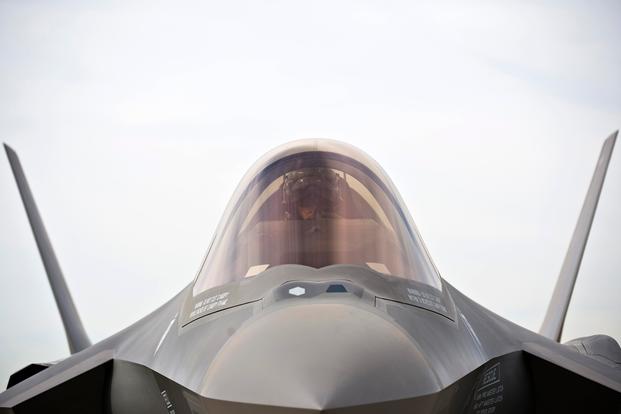ABOARD A C-37 MILITARY AIRCRAFT -- U.S. military pilots who head to Nellis Air Force Base, Nevada, will soon find out what it's like to go up against an F-35 Joint Strike Fighter.
The service earlier this month announced that it is reactivating the 65th Aggressor Squadron and moving 11 F-35A Lightning IIs to the base to serve as aggressor air, or "red air," training. The move is part of a larger initiative to give pilots the experience they'll need in a high-end conflict.
While advanced jets acting as "red air" isn't new, the Air Force sees the necessity to craft an aggressor squadron made up entirely of the Pentagon's premier jet, according to the service's outgoing top civilian. She says it makes solid economic sense.
"And here's the reason: We're talking about the early F-35s, so in order to bring them up to Block 4 [software configuration] standards, it would take about $15 million a piece to retrofit them. Instead, we can use them as aggressors quite well," Air Force Secretary Heather Wilson told Military.com in a recent interview. "We need to be able to simulate a high-end adversary, and this is a pretty cost-effective way to do it."
Related content:
Military.com traveled with Wilson on one of her last trips to Air University at Maxwell Air Force Base, Alabama, on May 14 before she departs the Pentagon on Friday to take her new position as president of the University of Texas at El Paso.
Two of the F-35s are coming from Edwards Air Force Base, California; Eglin Air Force Base, Florida, is providing the rest. Eglin is planning for new F-35s on its flight lines; its older fifth-generation fighters won't transfer to Nellis until at least 2022, the service said in a release.
China's Chengdu J-20 and Russia's Su-57 stealth fighter are pushing the United States in the competition to possess the best fifth-generation fighters in the world.
U.S. fighter pilots are eager to train against a stronger adversary.
"The F-22 [Raptor] guys are hungry to get at a fifth-gen adversary like a [Chinese] J-20," a fighter pilot told Military.com in 2017. "The problem is, no squadron can replicate it unless you have dedicated fighter [squadrons of aircraft like the F-35 or F-22] acting as adversary air."
Pilots attend Nellis' Weapons School -- the Air Force's version of "Top Gun," stood up after the Vietnam War -- to train on the latest and greatest techniques.
Using the F-35s "will allow our pilots to study adversary tactics," Wilson said.
"Right now, our F-35s out at Nellis, they see everybody so far away, and they kill them so fast, it is a delightful, unfair fight," she added. "We have to prepare for the high-end fight, and that means train our pilots ... against fifth-generation aircraft. We've got to do that somehow."
-- Oriana Pawlyk can be reached at oriana.pawlyk@military.com. Follow her on Twitter at @Oriana0214.













